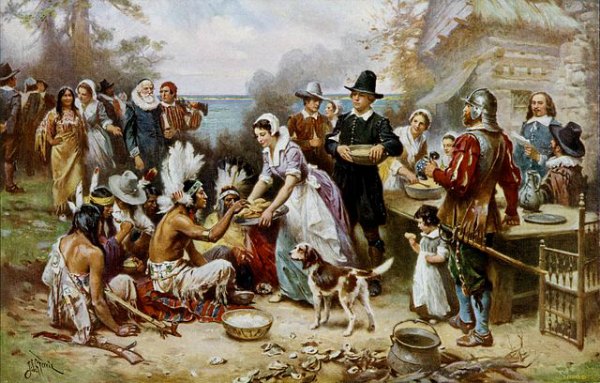 Tom ClarkWe actually enjoy Thanksgiving
Tom ClarkWe actually enjoy Thanksgiving
The history of Thanksgiving – how it came to be, and what it means:
In 1620 English settlers arrived in “Massachusetts” from England.
In the fall of 1621 they invited the Indians to join them in thanking God
for having carried them through a difficult first year.
The settlers observed Thanksgiving for many years in the interest of promoting faith in Christ.
Until 1682 Thanksgiving proclamations were made, primarily by church leaders,
and then by both government and church leaders until after the American Revolution.
Following that first observance of “Thanksgiving” there were additional observances:
During the American Revolution the Continental Congress designated one or more days of Thanksgiving each year.
In 1789 George Washington issued the first Thanksgiving proclamation by the new government of the United States. As President, Washington called on Americans to express their gratitude for the happy conclusion to the country’s
War of Independence, and the successful ratification of the U.S. Constitution.
As one who believed in Christ, George Washington encouraged Americans to observe Thanksgiving for two reasons:
1. To focus on God and praise Him for His blessings on the nation.
2. As a way of encouraging people to exercise faith in Christ.
In 1817, New York became the first of several states to officially adopt an annual Thanksgiving holiday.
In 1827, magazine editor and author of “Mary Had a Little Lamb,” Sarah Josepha Hale launched a
campaign to establish Thanksgiving as a national holiday.
For 36 years she published editorials, and wrote to governors, senators, Presidents and other politicians.
In 1863, at the height of the Civil War, President Abraham Lincoln fulfilled Sarah Josepha Hale’s quest
by proclaiming a national “Thanksgiving Day” to be observed each November.
Lincoln entreated all Americans to ask God to “commend to His tender care all those who have become widows,
orphans, mourners or sufferers in the lamentable civil strife” and to “heal the wounds of the nation.”
Lincoln declared Thanksgiving should be observed on the final Thursday in November.
Thanksgiving was celebrated that day every year until 1939 when President Franklin D. Roosevelt moved
the holiday up a week in an attempt to spur retail sales during the Great Depression.
In 1941 Roosevelt signed a bill making Thanksgiving the fourth Thursday in November.
This then, is a summary of how Thanksgiving has evolved:
We observe Thanksgiving every November as a standard American holiday.
The original observance of Thanksgiving had a spiritual emphasis and was a pursuit of Godliness.
In our current culture, most people observe Thanksgiving annually, but for many it is not for spiritual reasons.
Many just enjoy a pleasant observance of the material blessings of the nation.
But, if we want to celebrate Thanksgiving as a way of acknowledging God – and of Christ as our Savior –
it becomes a recognition of God’s grace toward us.
John 3:16-18 – ESV
16 God so loved the world, that He gave His only Son, that whoever believes in Him should not perish but have eternal life.
17 For God did not send his Son into the world to condemn the world, but in order that the world might be saved through him.
18 Whoever believes in him is not condemned, but whoever does not believe is condemned already, because he has not believed in the name of the only Son of God.
Romans 8:1-2 – ESV
1 There is therefore now no condemnation for those who are in Christ Jesus.
2 For the law of the Spirit of life has set you free in Christ Jesus from the law of sin and death.
These verses help us to understand the idea of faith in Christ and of life in heaven.
Whether we believe in Christ or not, we can enjoy Thanksgiving.
But if we do trust in Christ our Thanksgiving is a celebration of joy in God and His grace toward us.





